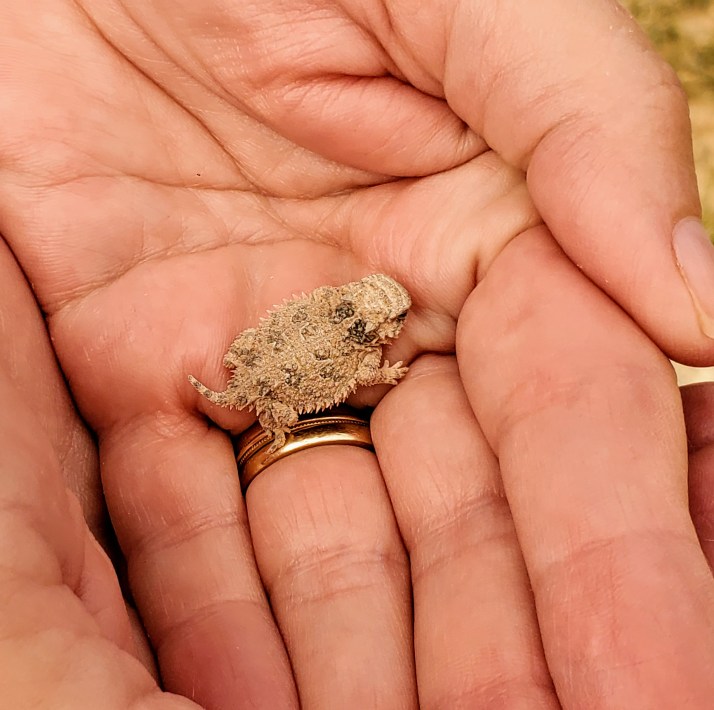Canyon, Texas

I have found the perfect trip to take during these days of Covid-19!
Why not check out Palo Duro Canyon State Park and visit our nation’s second largest canyon? Consider it a mini Grand Canyon and one of Texas’s best kept secrets. This park covers 30,000 acres and is located a few miles outside of Amarillo in the Texas Panhandle. Palo Duro Canyon offers spectacular views, fun outdoor activities, lots of fresh air and few social interactions with others. Why not get a change of scenery, have a great time and enjoy nature – all while social distancing? Win, win!

My husband and I recently drove to Palo Duro Canyon (6 hours from DFW) and stayed in a wonderful cabin (Skyhouse @ Dove’s Rest Cabins) five minutes away from the park entrance and spent two days in the park. If you go, be sure to purchase your State Park day passes on-line a few weeks in advance due to limited availability. Tickets are only $8 per vehicle per day and the park is currently open 7:00 a.m. until 7:00 p.m.
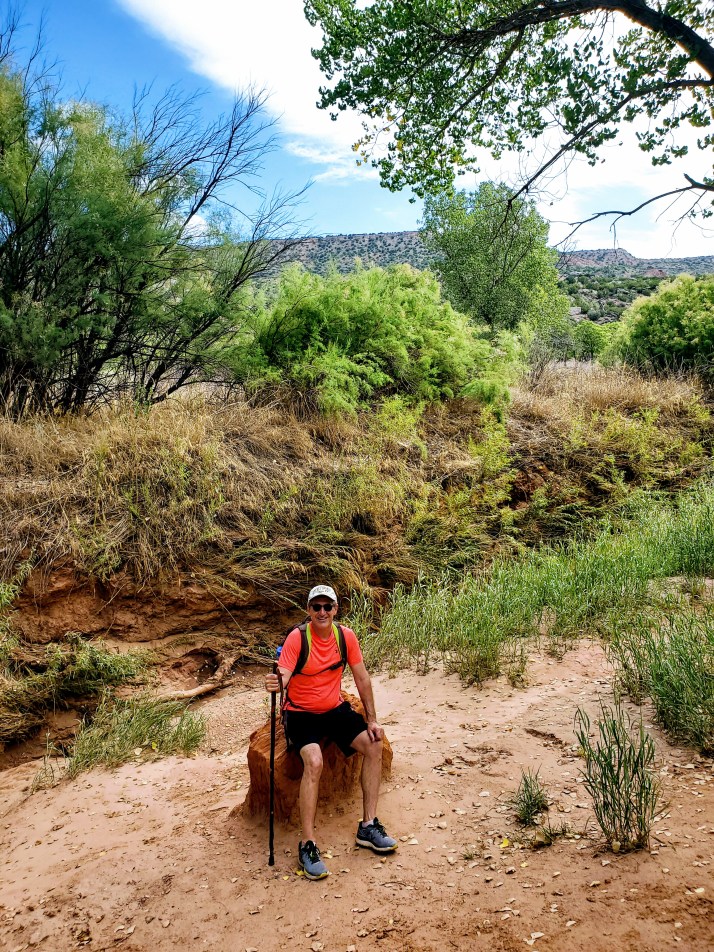
The morning we arrived, there were only a couple of cars ahead of us checking into the park. After entering through the main gate, there were 16 miles of paved roads ahead of us that descended 800 feet to the canyon floor. We stopped along the park road several times and enjoyed fantastic scenic views, historical sites and markers, picnic tables, miles of hiking trails and the visitor center (with limited hours). There were also public restrooms, biking trails, horseback riding trails, a souvenir shop with grill, camping areas suitable for day trips, and overnight tent camping. Several areas were closed due to the pandemic, including the outdoor amphitheater and park cabins, but there was still plenty to see and do.

We were there on a Sunday and Monday and may have seen two dozen people – tops! The parking lots, trails and roads were nearly empty. We passed a couple of people on each trail we were on. The most people we saw in one place happened to be at a snow cone stand at one of the major trail heads. It was great!

Our first morning hike in the park was on the Pioneer Nature Trail that looped down to the river and back. It is a popular place to spot Texas horned lizards/toads/frogs (my daughter graduated from TCU so I will hereafter refer to them as horned frogs!). We found three snake skins (yikes! lots of rattlesnakes in the canyon), small lizards, tons of red ants (horned frog food), and a half-eaten coyote pup skeleton. Near the end of our hike on this trail, lo and behold, we came across a Texas horned frog. He froze, we took pics, and went on our merry way. I was a happy camper!
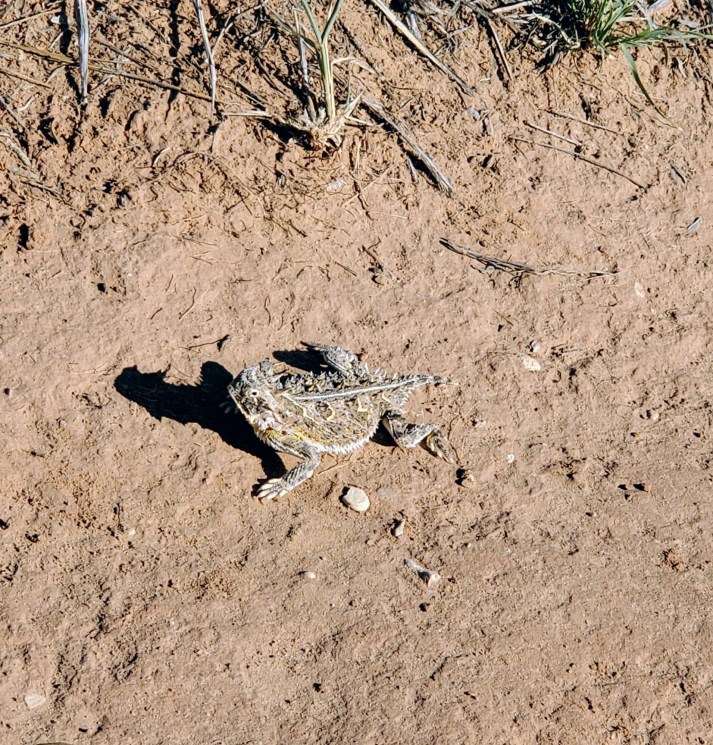
We then hiked a short distance off-trail around the site of the historic Battle of Palo Duro Canyon where the high red walls and percolation caves (caused by wind and water) reminded us of the rock formations in Sedona. This whole area has that eerie “battlefield” feeling I have felt other places – it just makes me feel sad and uneasy remembering the history and loss of life here. The vibe is unsettling and disturbing. You can read more about what happened here at the end of this article.
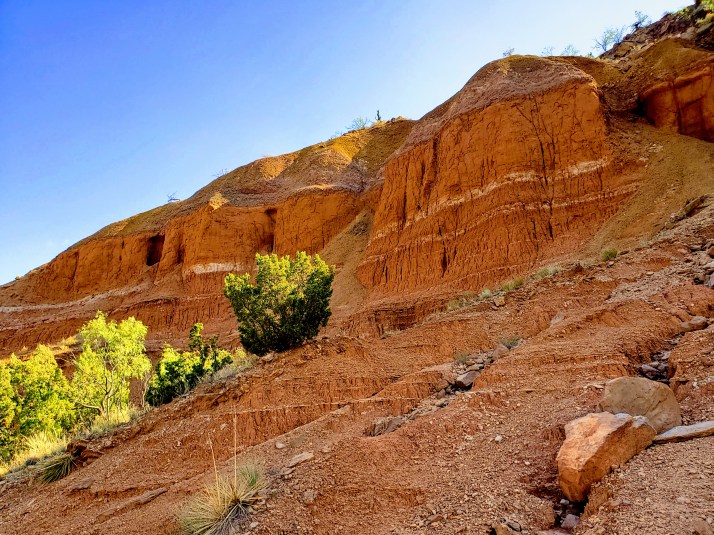
Back on the main road, we chose the Sunflower Trail for our next hike and it was my favorite of the trip. This trail led us alongside a creek on one side and a large red, Permian wall on the other. This 300 million-year-old wall had beautiful horizontal veins of shiny white gypsum running through it. Most of the trail was shaded by tall cottonwoods and the clay-like ground underfoot was filled with animal tracks. We recognized raccoon, deer, rabbit, bobcat, coyote, and mountain lion tracks. I don’t think I would want to be on this trail at night! We also had to avoid stepping in piles of wildlife scat along the way that was teeming with iridescent dung beetles. The circle of life is alive and well in the canyon!


The following day began at the visitor center where we enjoyed the scenic view from the overlook at the canyon rim. We drove halfway down into the canyon and hiked off-trail again to climb a large prominent rock that overlooked the canyon floor. The views from there were amazing. This trail was full of cacti and the climb was not easy but I made it! We had to be very careful where we were stepping and constantly be on the lookout for snakes, scorpions and centipedes. Many things were ready and willing to stick, bite or sting!
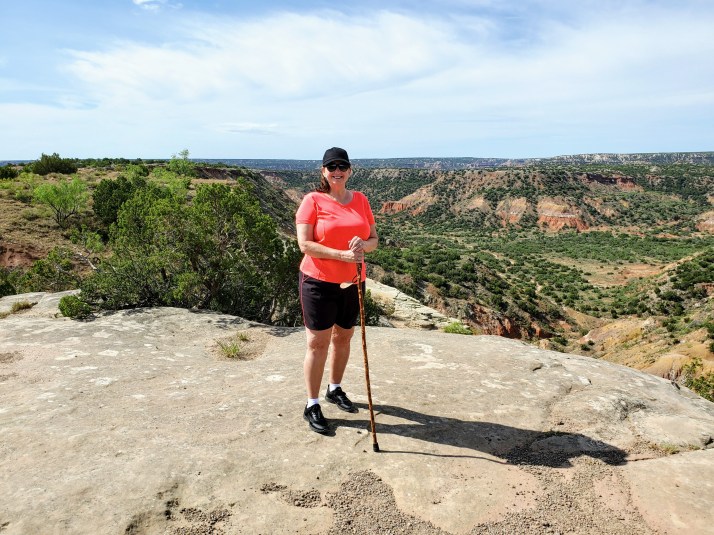
We hiked back to our car, drove a little further into the canyon and parked near the Kiowa trail head. We walked along the Kiowa Trail and followed a dry creek bed through mesquite groves for great views of another prehistoric Permian wall formation that gives the river its red color. We didn’t spot any wildlife here but saw many animal trails and tons of grasshoppers that would suddenly fly up and scare the bejesus out of you!


Later that afternoon we found ourselves at the Lighthouse trail head. This is the most popular trail and leads to the iconic Lighthouse Rock “hoodoo,” the symbol of the park. This is a six-mile hike round trip and where most of the park’s heat-related injuries and deaths for people and pets occur. We were warned to not start this hike if the temp was above 80 degrees (it was) and not unless you have at least one gallon of water per person (we didn’t). We decided to hike down the trail far enough to see the Lighthouse, take a pic, and head back – which is what we did. We then made a beeline to the snow cone stand in the parking lot!
Note: the canyon floor is always 10 to 15 degrees warmer than the temperature on the canyon rim. It was hot! hot! hot!!
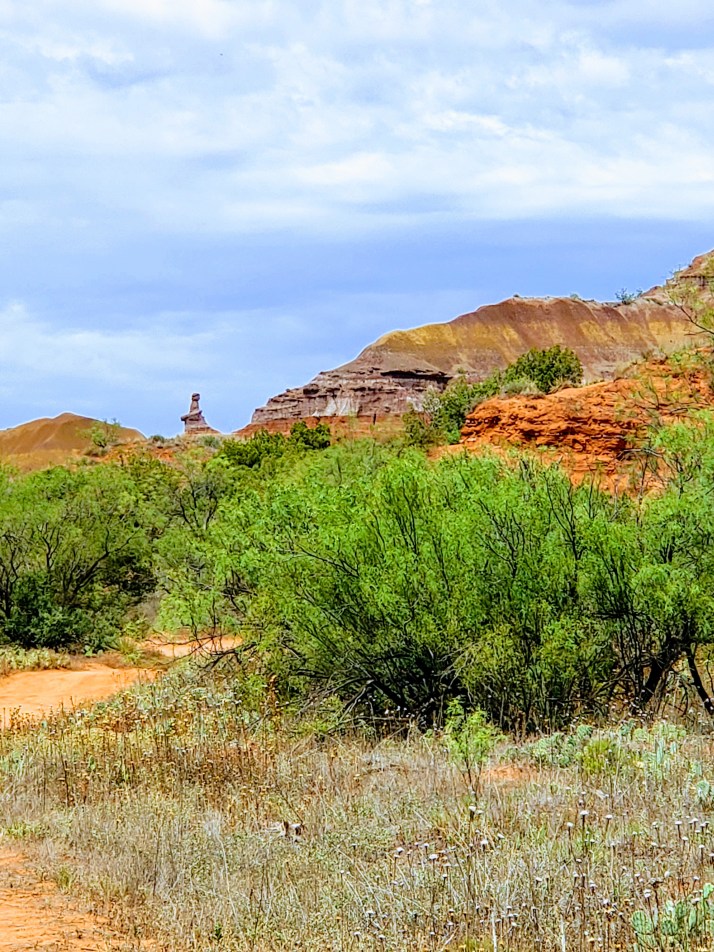
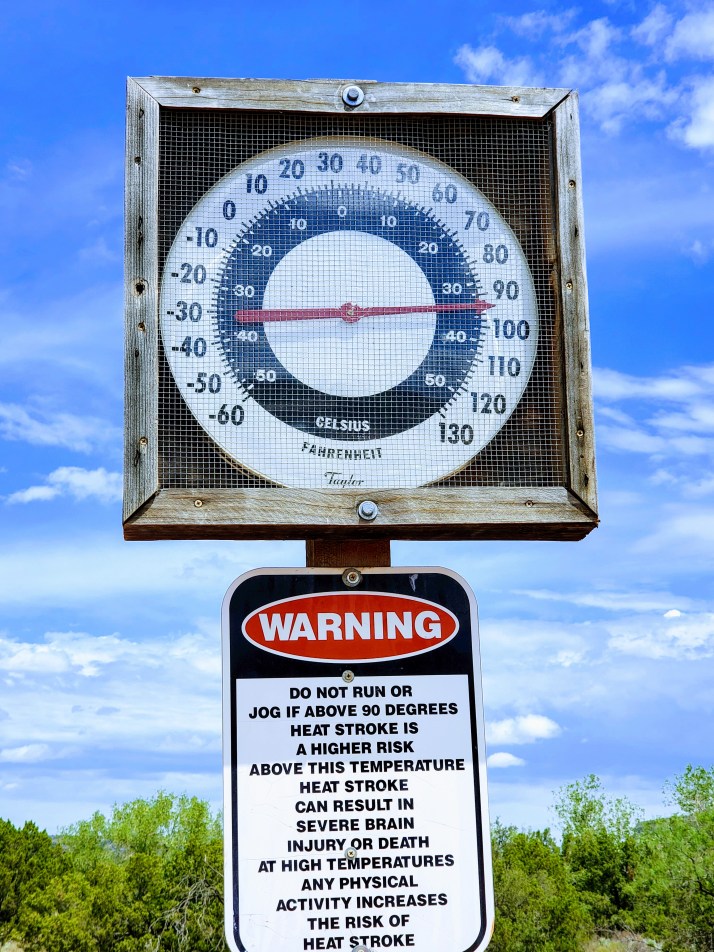
Afterward our much-enjoyed snow cone, we made a couple of brief stops at pull-outs and had a picnic lunch. We saw more beautiful rock formations, a big green lizard, and a turkey. After two full days of exploring the park and canyon, our trip was coming to a close. We enjoyed it immensely and I would love to visit again in the spring or fall when temps are a little cooler. One major highlight of our trip (besides the gorgeous scenery) was that the lack of crowds could not be beat!

More information on the park itself:
People have been a part of this scenic canyon for 12,000 years where they hunted large herds of mammoth and giant bison. More recently, the Apache, Comanche and Kiowa Native American tribes called this canyon home. They left behind rock art, arrowheads, and pottery shards that clue us into their way of life here. Early Spanish adventurers exploring the canyon, named it Palo Duro, Spanish for hard wood. The visitor center has a video and some of these artifacts, fossils and relics if you are interested.
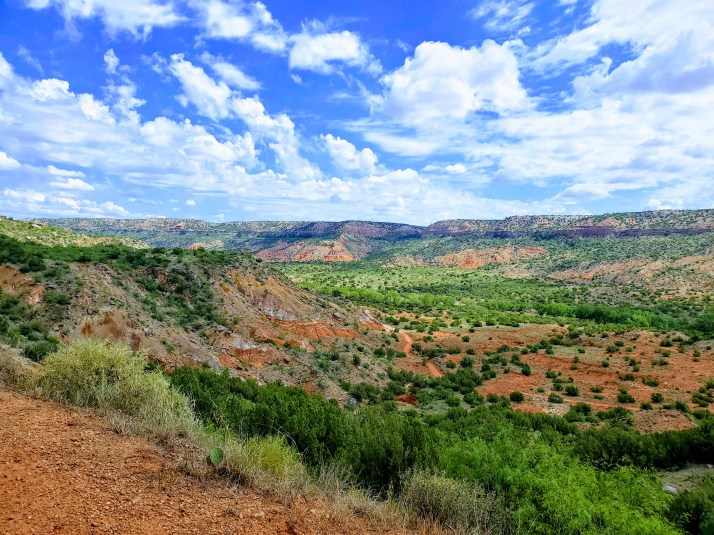
For you history buffs – a large part of this canyon’s history centers around the Red River War and the Battle of Palo Duro Canyon (mentioned above) which was an ongoing battle between the U.S. Army and the Plains Indians. In 1874, the U.S. Calvary attacked a large camp of Comanches, Kiowas, and Cheyennes at dawn. Many in the camp fled throughout the canyon while the army attacked the surprised natives, captured 1,500 horses (and killed 1,100 after taking their picks), burned all the teepees, food, clothing, tools, and provisions. With no horses or winter supplies, the remaining Native Americans had no choice but to surrender themselves to the reservations. A marker now stands in the far end of the canyon and details this battle. As you stand in this spot, it is easy to visualize the haunting event that took place on these grounds and to imagine the sounds of the guns and the screams of the frightened people and horses. It is a bitter pill for me to swallow.
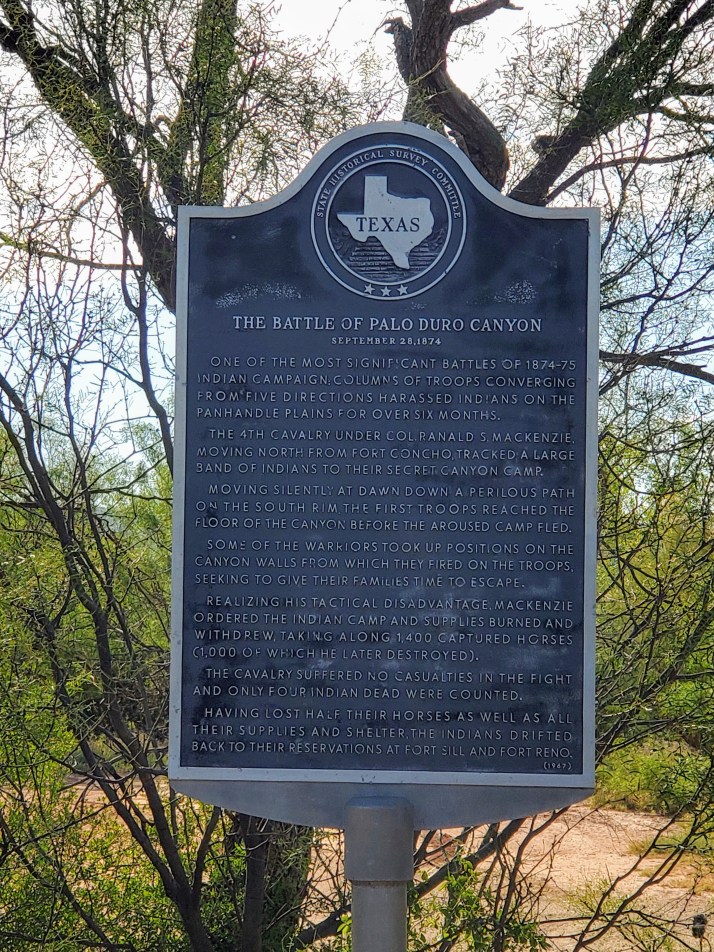
With the Native Americans out of the way, the canyon and surrounding area quickly moved into the “ranch era.” The resident buffalo were hunted almost to extinction for their hides and their carcasses were left to rot and be eaten by scavengers. The few small buffalo herds that remained were run out by the ranchers to make way for longhorns. The State of Texas bought this land for the park in 1933 after it had been used as a cattle ranch since the late 1800s.

Currently Palo Duro Canyon State Park is ranked the “number one” State Park in Texas and ranks in the “top twenty” of U.S. State Parks according to several travel guides. No surprise there!
My husband and I thoroughly enjoyed our days spent in the park. It was a great little trip and a nice change of scenery. If you are a fan of the outdoors and enjoy hiking, rock formations and wildlife and don’t mind red dirt, cacti, and being up close and personal with nature – plan your trip today. I hope to go back soon so maybe I will cross paths with you there.
See you on the trails!
